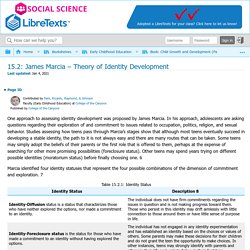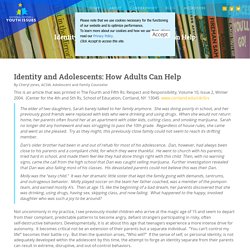

What is adolescence? What forging a sense of identity means. Who we will be learning from. Physical, Cognitive and Social Development in Adolescence Amidst Seeking a Sense of Identity. Learning Objectives Summarize the physical and cognitive changes that occur for boys and girls during adolescence.Explain how adolescents develop a sense of morality and of self-identity.

Adolescence is defined as the years between the onset of puberty and the beginning of adulthood. In the past, when people were likely to marry in their early 20s or younger, this period might have lasted only 10 years or less — starting roughly between ages 12 and 13 and ending by age 20, at which time the child got a job or went to work on the family farm, married, and started his or her own family. Today, children mature more slowly, move away from home at later ages, and maintain ties with their parents longer.
For instance, children may go away to university but still receive financial support from parents, and they may come home on weekends or even to live for extended time periods. Introductory Video: 8 Stages of Development by Erik Erikson. Erik Erikson's Stages of Psychosocial Development. Erik Erikson was an ego psychologist who developed one of the most popular and influential theories of development. While his theory was impacted by psychoanalyst Sigmund Freud's work, Erikson's theory centered on psychosocial development rather than psychosexual development.
The stages that make up his theory are as follows:1 Let's take a closer look at the background and different stages that make up Erikson's psychosocial theory. Through Erikson's Lens: Understanding adolescents' strive to forge a sense of identity. Video: A Simple Look at Identity vs. Role Confusion. Introductory Video: Marcia's States of Adolescent Identity Development. Marcia's Four Identity Statuses. One approach to assessing identity development was proposed by James Marcia.

In his approach, adolescents are asking questions regarding their exploration of and commitment to issues related to occupation, politics, religion, and sexual behavior. Studies assessing how teens pass through Marcia’s stages show that although most teens eventually succeed in developing a stable identity, the path to it is not always easy and there are many routes that can be taken. Some teens may simply adopt the beliefs of their parents or the first role that is offered to them, perhaps at the expense of searching for other more promising possibilities (foreclosure status). Other teens may spend years trying on different possible identities (moratorium status) before finally choosing one. 6. Through Marcia's Lens: Understanding adolescents' strive to forge a sense of identity. Video: A Simple Look at How Marcia's Identity Statuses May Look Like.
Research Article: Friendship Characteristics, Psychosocial Development, and Adolescent Identity Formation. Research Article: Identity Statuses throughout Adolescence and Emerging Adulthood. Research Article: Trajectories of Identity Formation Modes and Their Personality Context in Adolescence. Adolescent Identity Development: What to Expect in Teens. Adolescent Identity Development: The Factors of Change Among the profound and exciting changes taking place in adolescence is the process of self-discovery. Our teens are working to figure out who they are, making adolescent identity development a central feature of teen life. Young people’s identities are shaped by lots of factors — family, cultural and societal expectations, experiences with institutions like school and the media, and friends.
Young people also take active steps and make choices that shape their identity. They select the environments and people they want to be around. Identity and Adolescents: How Adults Can Help. By Cheryl Jones, ACSW, Adolescent and Family Counselor This is an article that was printed in The Fourth and Fifth Rs: Respect and Responsibility, Volume 10, Issue 2, Winter 2004.

(Center for the 4th and 5th Rs, School of Education, Cortland, NY 13045 www.cortland.edu/c4n5rs. How To Help My Young Adult with Identity Development. “I am most excited about the freedom that I will have when I graduate from high school.

The freedom that I am searching for is not to escape my family or anything of the sorts, but the freedom of going to a college and being myself.” - Lexie, Class of 2017, Summersville, WV Throughout their lifetime, your kids have been developing a sense of self, of identity, and self-awareness. 6 Ways You Make a Difference as a Parent. Real Families.

Real Hope. Offer God's hope to hurting families. Yes, I will help struggling families! Español Helping Families Thrive™ Video: Parenting Your Adolescent's Self-Identity & Self-Esteem.